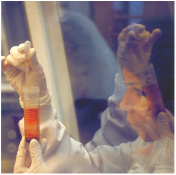
Current Projects - Mixed platelet populations
|
|
Platelets are continually formed and released from the bone marrow into the circulating blood. In healthy individuals the platelets then remain in the circulation for around 7-10 days, after which time they are removed. So in the average day we turn over about 10-15% of our platelets. In people with conditions such as diabetes platelets survive less well in the circulation and may only last for 5 days or so. This equates to a turnover of 20% of our platelets each day.
Aspirin and the P2Y12 receptor blockers clopidogrel and prasugrel are only taken once a day, they are short-lived in the body, and they block platelets irreversibly. Clinical evidence suggests that anti-platelet drugs are less effective in people with diabetes and other conditions associated with faster platelet turnover. It has been suggested that the explanation for this loss of effectiveness is that in these conditions lots of newly formed, uninhibited platelets are released into the circulation each day. These uninhibited platelets could form the centre of platelet thrombi and so increase the chances of heart attacks and strokes. After a number of years of painstaking work, mostly by Thomas Hoefer, we published our first paper in this area in the journal Arteriosclerosis, Thrombosis and Vascular Biology in 2015 with a follow up in the same journal in 2017. Further work in this area helped us understand how platelets change in trauma and we are now focussing on understanding how platelets change as the age in the circulation (supported by programme grant funding from the BHF). (Slide presentation to the top left shows some of our data, and the video below it shows a platelet aggregate formed of uninhibited platelets (green) making a core surrounded by inhibited platelets (red)). |